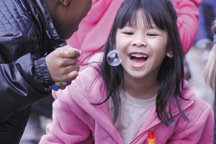While many of the older students at Woodrow Wilson School in Bayonne knew that they had come out to the schoolyard to blow bubbles to make the public aware of autism, nearly all the students – young and old – understood that they were part of an effort to break the international Guinness Book of World Records for the number of people blowing bubbles at the same time for a whole minute.
Woodrow Wilson, with its 10 classes for autistic students, serves as the district’s principal location for classes that provide these students with basic life skills and other training. So it was an appropriate place to hold the event and raise awareness in the community of Bayonne about the needs of such students.
School Principal Charles Costello said Woodrow Wilson has 10 classrooms dedicated to autistic children, and many of the other students, who came out into the yard to blow bubbles, knew of or interacted with these students during the year.
“Every bubble will signify a special message of hope and create a greater awareness of autism.” — Marguerite Baber
____________
Yash Shah, a seventh grader, said he was looking forward to being part of the world record, as was his classmate Devin Restrepo.
Seventh grader Jashawn Baker said he was aware of the wider implications of the event from viewing local television, as did seventh grader Erslan Shaw.
“I’m here to blow bubbles and chill with my friends,” said Neal Kiniery.
Alan Smarz, a teacher’s aide, didn’t blow bubbles. He was walking around inside a six-foot tall white rabbit suit.
In cooperation with The Simpson-Baber Foundation for the Autistic, students, faculty, and others joined in the collaborative effort.
“Every bubble will signify a special message of hope and create a greater awareness of autism,” said Marguerite Baber, founder of the foundation, prior to the event.
“The Bayonne School District recognizes Autism Awareness Month as an important opportunity to promote awareness and support The Simpson-Baber Foundation for the Autistic, our partner in the Busy Bee Program for Children with Autism at Bayonne Medical Center,” said Dr. Patricia McGeehan, superintendent of the Bayonne School District. “Busy Bee is an early-intervention program, which is a collaboration of the Board of Education, the foundation, the Bayonne Medical Center, and the city of Bayonne.”
In addition to “Blowing Bubbles for Autism,” the Bayonne School District and numerous community partners have also planned the seventh annual Hand in Hand Across Bayonne fundraising drive. Parents and students have been asked to participate in the program by purchasing a “caring hand” for a donation of $1 or more. The hands will be displayed throughout the schools. All contributions will be forwarded to The Simpson-Baber Foundation to benefit autism programs.
Sharon Colasurdo, superintendent of the school’s autistic programs, said the goal was to break the previous record of 37,000 people blowing bubbles at the same time, a record Costello felt confident would be broken.
“We’re joining people everywhere in this effort,” she said.
Woodrow Wilson is one of two Bayonne schools that offer programs for autistic students. These make up the middle piece in a comprehensive series of programs in Bayonne that help autistic kids from pre-school through high school, and even somewhat beyond.
What is autism?
Autism impairs brain development in the areas of social interaction and communication and impacts one out of every 110 children. Symptoms could include inappropriate play; extreme social withdrawal; intense discomfort with new situations, people, or surroundings; preoccupation and fixation; or behavioral problems. Autism is a nightmare for parents, Baber said, because children don’t follow the usual progression you would expect. Caught up in their own mental loop, autistic children do not develop in the natural way, learning lessons from experience the way most children do. They can learn and develop, but often this is a time-consuming and very frustrating effort.
For pre-school kids, Bayonne has the Busy Bee Center for Children with Autism, located at Bayonne Medical Center. It is an early intervention program that is celebrating its 10th anniversary this September. This is a cooperative effort of the City of Bayonne, the Bayonne Board of Education, and The Simpson-Baber Foundation.
Starting with the Busy Bee program, students come into the elementary school, where they continue to build a base of experience to carry on into high school, where an even more comprehensive program helps them learn working skills.
The more the students do in elementary classes to learn the basic lessons of life, the better prepared they are to begin using them in a more social setting, where many of them go off to unpaid and paid internships with local businesses.
At the high school, each student gets a vocational assessment, giving educators an idea of their level of skills. Some may go on to college. Some may go into trade schools. Some may even transition into jobs or into programs where they can continue to use the skills they learned.
Al Sullivan may be reached at asullivan@hudsonreporter.com.
